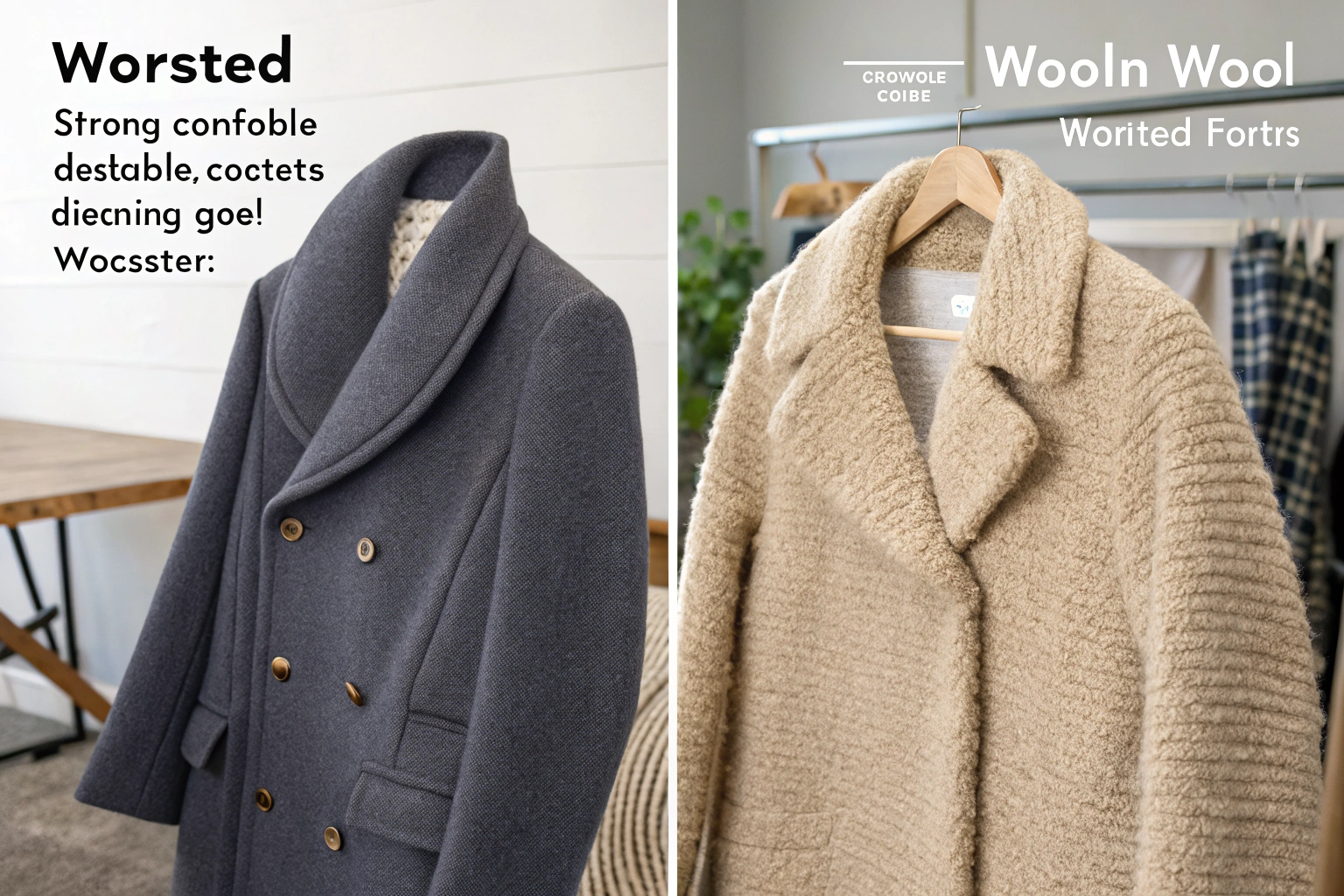As a U.S. apparel brand owner, you know that fabric choice is critical. Your customers demand quality, comfort, and style. Selecting the right wool fabric can make or break a collection. Understanding the difference between worsted and woolen wool is not just a technicality; it's a business decision that impacts your product's look, feel, and performance. Many brands face confusion here, leading to garments that don't meet market expectations. This guide will clarify these two distinct types of wool, empowering you to make informed sourcing choices for your next line.
Worsted and woolen are two distinct wool processing methods resulting in fabrics with different characteristics. Worsted wool uses long, parallel fibers to create a smooth, strong, and durable fabric ideal for tailored garments like suits. Woolen wool uses shorter, irregular fibers to produce a softer, fuzzier, and warmer fabric, perfect for cozy knitwear like sweaters. The key difference lies in the preparation of the wool fibers before spinning.
Choosing the right wool is a strategic step in apparel manufacturing. It affects everything from the final product's aesthetic to its price point and target season. Let's unravel the details behind these two wool types to ensure your next order aligns perfectly with your brand's vision.
What is the worsted wool production process?
The journey of worsted wool begins with a focus on precision and length. This method is designed to highlight the best qualities of the wool fiber, creating a refined and high-performance fabric. The process is more extensive than woolen, requiring several additional steps to achieve its signature smoothness. As a manufacturer, we see this process as an investment in quality that pays off in the final garment's superior drape and durability.
The worsted process starts with selecting raw wool. We choose only long-staple fibers, typically over 2.5 inches. These longer fibers are essential for creating the strong, smooth yarn that defines worsted wool. The first step is scouring, where the raw wool is thoroughly washed to remove natural impurities like grease, dirt, and sweat. This is a critical stage for ensuring a clean base for processing.
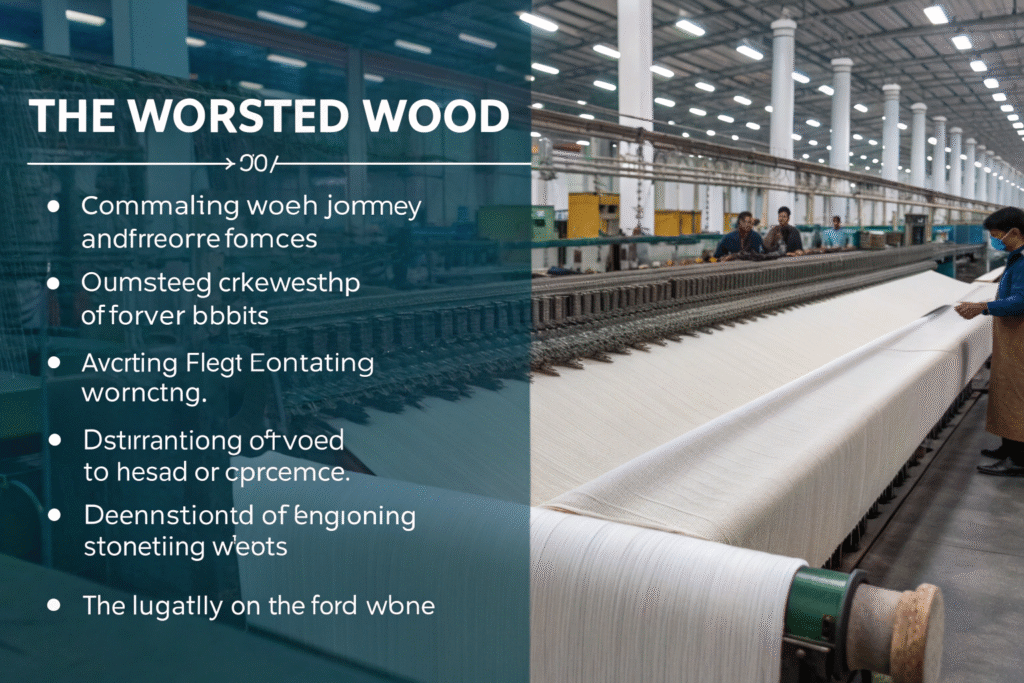
How is worsted wool yarn spun?
After scouring, the wool undergoes a crucial step called carding. Carding passes the fibers through fine wires to separate and align them roughly, forming a loose rope called a sliver. However, for worsted wool, the next step is what sets it apart: combing. The sliver is fed through combs that remove all the short fibers, known as noils, and any remaining vegetable matter. This leaves only the long, parallel fibers, creating a top. This combing process is the heart of the worsted method. It ensures uniformity and removes weaker elements, resulting in a stronger, finer yarn.
The prepared top is then drawn out and spun. During spinning, the long fibers are twisted tightly together. This creates a compact, fine, and incredibly strong yarn. The surface of worsted yarn is smooth because the fibers are all aligned and the short, prickly fibers have been removed. This yarn is then woven into fabric, often with a tight weave like gabardine or twill. The final fabric is then finished, which may include processes like steaming and pressing to enhance its smooth hand feel and sharp appearance. For brands focused on tailored clothing, understanding this process is key to appreciating the value of a well-made worsted wool suit.
What are the key characteristics of worsted wool fabric?
Worsted wool fabrics are known for their distinct set of properties that make them a premium choice. First is their smoothness. The aligned long fibers create a flat, even surface that feels sleek to the touch. This lack of fuzz contributes to its sharp, clean appearance, which holds a crease exceptionally well. This is why worsted wool is the gold standard for business suits and formal trousers. Its durability is another major advantage. The long fibers and tight spin create a yarn that is highly resistant to abrasion and pilling.
| Characteristic | Description | Ideal For |
|---|---|---|
| Surface | Smooth, flat, with a clear weave pattern | Tailored garments, professional wear |
| Drape | Excellent, fluid drape that hangs well | Suits, blazers, dresses |
| Durability | High resistance to pilling and wear | Garments intended for frequent use |
| Weight | Often lighter in weight despite being dense | Year-round suiting |
| Warmth | Less air trapped, so less insulating than woolen | Spring, Fall, and climate-controlled environments |
Furthermore, worsted wool has a crisp hand feel and a natural luster. It drapes beautifully on the body, creating elegant silhouettes. While it provides warmth, it is less insulating than woolen wool because the tight weave traps less air. This makes it a versatile choice for garments worn in cooler spring and fall months or in air-conditioned offices. For brands targeting the corporate or formal wear market, worsted wool from a reliable apparel manufacturer is a non-negotiable element of a quality collection.
What defines the woolen wool manufacturing method?
In contrast to the precise worsted method, the woolen wool process embraces a more inclusive and textural approach. It is designed to create warmth and softness above all else. This method utilizes the full spectrum of wool fibers, including shorter ones that are discarded in the worsted process. For brands creating cozy, casual, or cold-weather apparel, understanding woolen wool is essential for achieving the desired aesthetic and functional properties.
The woolen process also begins with scouring the raw wool. However, the fiber selection is different. Woolen spinning uses shorter staple fibers, and there is no emphasis on separating them by length. The key preparatory step is carding. But unlike worsted carding, which aims to align, woolen carding is designed to create a web of fibers going in all different directions. This web is then divided into loose, soft ropes called rovings. The critical difference is the absence of the combing stage. This means all fibers, long and short, remain in the mix.
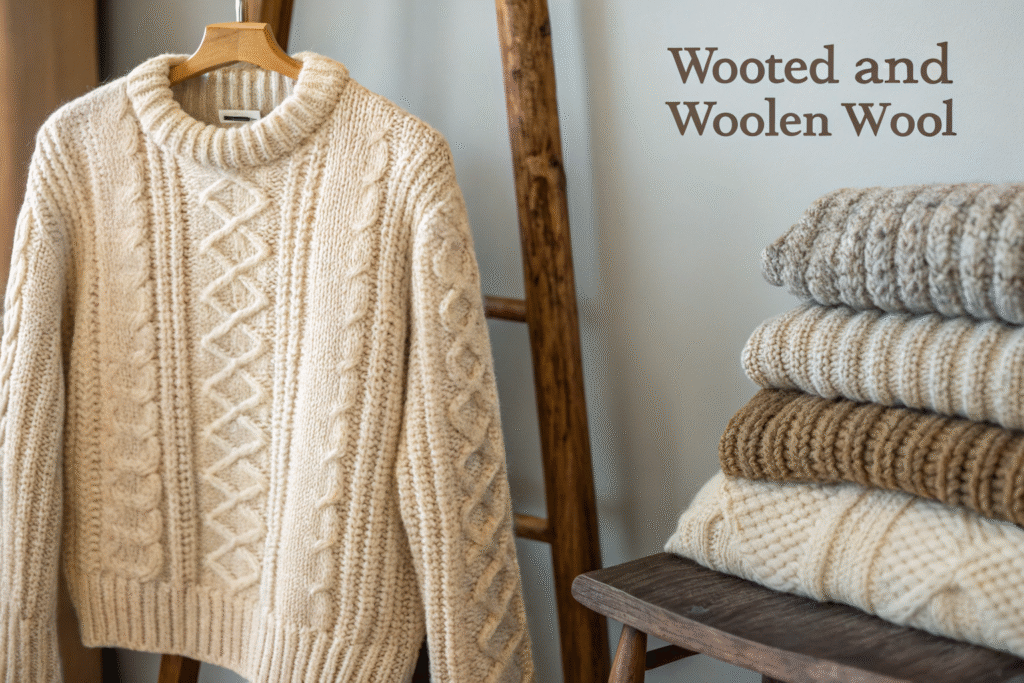
How does the woolen spinning technique work?
The spinning process for woolen yarn is fundamentally different. The roving, a loose assemblage of disorganized fibers, is spun with a lot of twist. However, because the fibers are not parallel, they buckle and bend during spinning. This action traps a significant amount of air within the yarn structure. The result is a bulkier, softer, and loftier yarn compared to worsted. The surface is inherently fuzzy due to the shorter fibers protruding in all directions.
This fuzzy surface, known as a nap, is a hallmark of woolen fabrics. It contributes greatly to their warmth and soft hand feel. The yarn is then knitted or woven, often into looser constructions to further enhance insulation. Common fabrics produced include melton, tweed, and flannel. These fabrics have a more rustic, textured appearance. They are beloved for their comfort and warmth, making them perfect for outerwear, sweaters, and blankets. When you source a chunky knit sweater, you are almost certainly looking at a product of the woolen wool method.
What are the main features of woolen wool fabric?
Woolen wool fabrics are defined by their warmth and texture. The primary feature is their exceptional insulation. The vast amount of air trapped within the lofty yarn acts as a superb thermal barrier. This makes woolen wool garments ideal for harsh winter conditions. The hand feel is noticeably soft and often brushed to raise the nap, increasing softness against the skin. However, this same texture means the fabric is more prone to pilling and has a less defined drape than worsted wool.
The appearance of woolen wool is more casual and rugged. It lacks the smooth, sharp finish of worsted wool, instead offering a rich, matte surface that can hide stains and wrinkles better. Its durability is good, but the looser structure may not withstand heavy abrasion as well as a tightly woven worsted fabric. For brands, this means woolen wool is a strategic choice for specific product lines:
- Outerwear: Coats and jackets where warmth is paramount.
- Knitwear: Sweaters, cardigans, and beanies that prioritize comfort.
- Casual Bottoms: Heavyweight trousers and skirts with a relaxed aesthetic.
- Accessories: Scarves, hats, and gloves that require softness and insulation.
Understanding these features allows you, the brand owner, to match the fabric to the garment's purpose accurately. Partnering with a factory experienced in both methods, like ours, ensures you get the right fabric with proper quality control for your specific designs.
Worsted vs Woolen: Which is better for apparel production?
The question of "better" is entirely dependent on the garment's intended use and your brand's target market. There is no universal winner. As an apparel manufacturer, our role is to guide our partners in selecting the right tool for the job. Choosing between worsted and woolen wool is a fundamental decision that impacts the garment's function, aesthetic, price, and customer perception.
A simple way to frame the decision is to consider the garment's formality and seasonality. Worsted wool is superior for structured, formal, and lightweight garments. Woolen wool is the champion for informal, soft, and ultra-warm pieces. Making the wrong choice can lead to customer dissatisfaction—imagine a winter coat that isn't warm enough or a business suit that looks fuzzy and casual.
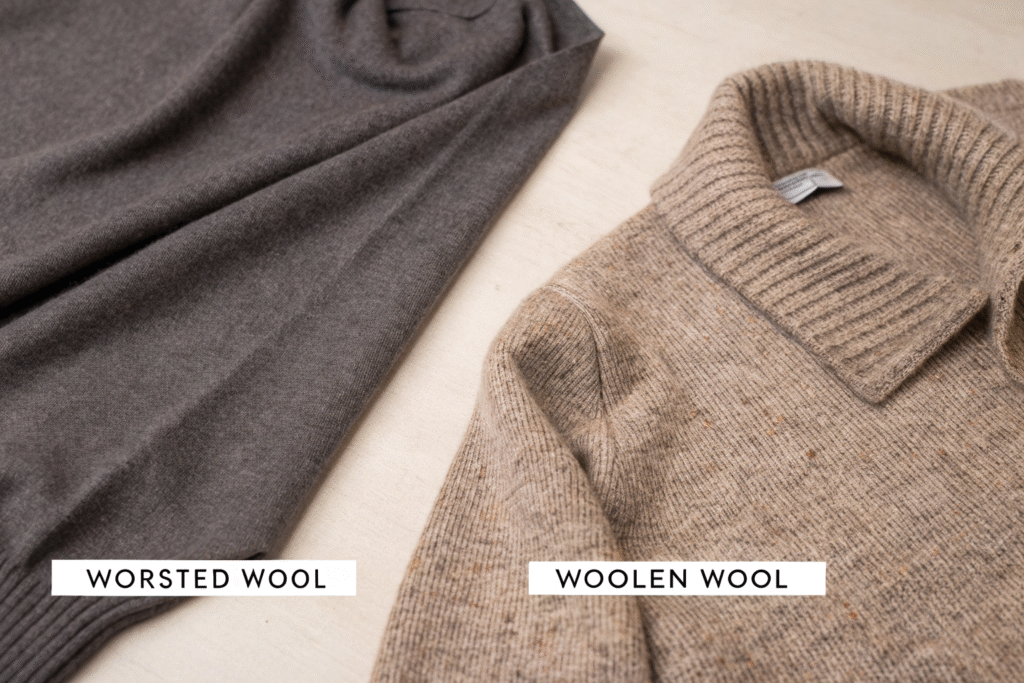
When should you choose worsted wool for your clothing line?
You should choose worsted wool when your priority is a sharp, polished, and professional look. Its superior drape and smooth finish make it the undisputed choice for tailored garments. If your brand operates in the following spaces, worsted wool should be a core material in your sourcing strategy:
- Business Attire: Suits, blazers, dress trousers, and skirts.
- Formal Wear: Tailored dresses and high-end uniforms.
- Year-Round Blazers: Garments that require a crisp appearance without heavy weight.
- Products where durability and a neat appearance are critical.
The refined nature of worsted wool also allows it to take dyes beautifully, resulting in rich, even colors. It is generally more expensive than woolen wool due to the longer, more labor-intensive manufacturing process. However, for the discerning customer, the investment is visible in the garment's performance and elegance. For brands focused on the DDP (Delivered Duty Paid) model, understanding this cost structure is vital for accurate pricing and margin calculation.
What types of garments are best suited for woolen wool?
Woolen wool is the go-to choice when the primary design goals are warmth, comfort, and a relaxed aesthetic. Its insulating properties and soft hand feel make it ideal for garments meant to be cozy and protective. Your brand should leverage woolen wool for collections targeting cold weather or casual lifestyles. Key applications include:
- Heavy Outerwear: Overcoats, peacoats, and duffle coats.
- Knitwear: Chunky sweaters, cardigans, and beanies.
- Casual Shirts & Blouses: Flannel shirts and soft, brushed blouses.
- Winter Accessories: Scarves, mittens, and earmuffs.
- Blankets and Throws.
Woolen wool fabrics, like tweed, also offer a unique aesthetic with their inherent texture and ability to blend colored fibers for a heathered look. This can be a strong selling point for brands emphasizing heritage, craftsmanship, or rustic charm. While it may not have the formal drape of worsted, its ability to provide exceptional warmth makes it a practical and popular choice for consumers. Ensuring your supplier has robust logistics capabilities is key to getting these seasonal items to market on time.
How to ensure quality when sourcing wool fabrics from China?
Sourcing high-quality wool fabrics, whether worsted or woolen, from China requires a proactive and knowledgeable approach. China has a highly developed textile industry capable of producing excellent materials, but as with any global sourcing, vigilance is key. Your pain points about quality control and certification are common, and addressing them starts with choosing the right manufacturing partner. A transparent and communicative factory is your greatest asset.
The first step is to go beyond price discussions. While competitive pricing is important, an unusually low quote can be a red flag for inferior wool blends or shortcuts in processing. Ask detailed questions about the wool's origin, its blend composition (e.g., 100% wool vs. wool/synthetic blends), and the specific manufacturing mill. A reputable supplier will be transparent about their supply chain.
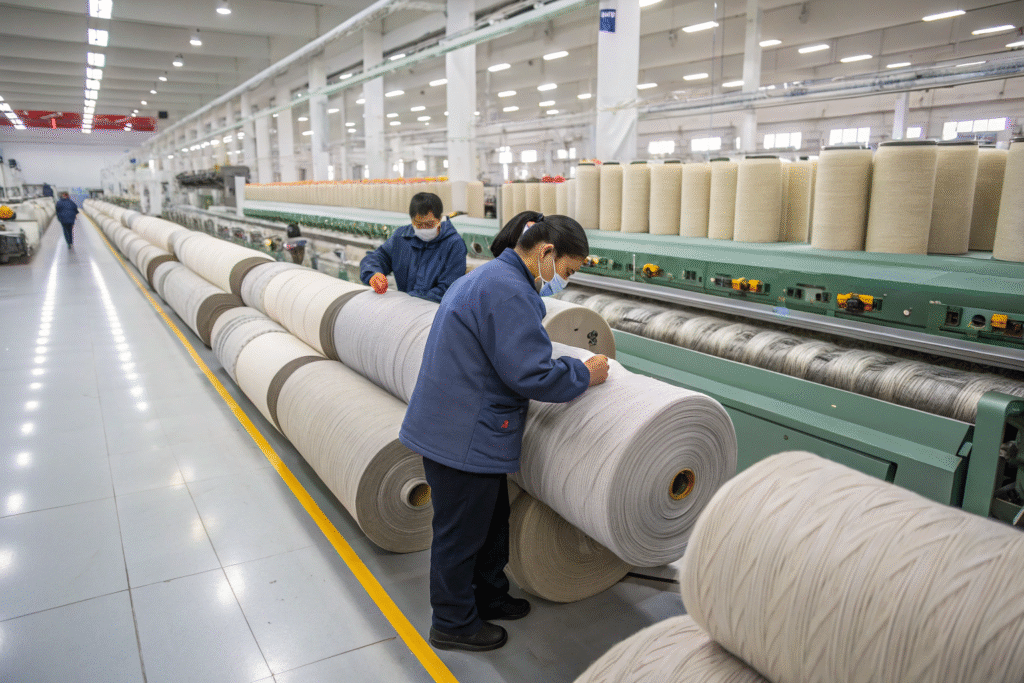
What quality certifications should you look for in a wool supplier?
Certifications are independent verifications of a supplier's claims and processes. They are crucial for mitigating the risk of falsified documents. When sourcing wool, insist on seeing relevant certifications. The most important one for wool is the Woolmark label. Administered by The Woolmark Company, this certification guarantees that the product is made from 100% pure new wool and has passed stringent quality tests. It is a globally recognized symbol of quality.
Other key certifications to request include:
- OEKO-TEX Standard 100: This certifies that the fabric has been tested for harmful substances, making it safe for human skin. This is especially important for brands focused on consumer safety and sustainability.
- ISO 9001 (Quality Management Systems): This indicates that the factory has established processes to maintain consistent quality in their production.
- SEDEX/SMETA (Ethical Trade): These audits ensure socially responsible practices in the factory.
A reliable partner will proudly provide these certificates. At our facility, we maintain these certifications and encourage our clients to verify them. This builds the trust necessary for a long-term partnership and protects your brand's reputation.
How can you verify fabric quality and manage logistics effectively?
Beyond paperwork, practical verification is essential. Always request fabric swatches before placing a large order. Examine the swatch for hand feel, weight, and color consistency. Perform simple tests, like stretching a corner of the swatch to check for recovery. For worsted wool, check for smoothness; for woolen, check for loftiness. Placing a trial order for a small batch of garments is an even better way to assess quality before full-scale production.
Effective logistics management is the final pillar. Delayed shipments are a major pain point. To avoid this, work with a supplier that offers clear communication and a proven track record of on-time delivery. Discuss their shipping options, lead times, and contingency plans upfront. A full-service manufacturer will handle the entire process, from fabric sourcing to finished garment delivery, including export documentation and shipping coordination. This integrated approach, often on a DDP basis, simplifies the process for you and reduces the risk of delays. By partnering with a manufacturer that prioritizes clear communication and robust payment methods, you can transform sourcing from a challenge into a competitive advantage.
Conclusion
Understanding the fundamental differences between worsted and woolen wool is more than a textile lesson; it is a crucial business skill for any apparel brand. Worsted wool, with its smooth finish and elegant drape, is the foundation of professional and tailored clothing. Woolen wool, prized for its softness and exceptional warmth, is the ideal choice for casual and cold-weather garments. There is no superior option—only the right choice for your specific product and customer.
By comprehending these distinctions, you can make smarter sourcing decisions, develop products that truly meet market needs, and communicate the value of your garments to your customers with confidence. This knowledge empowers you to ask the right questions and set the correct expectations with your manufacturing partner. The goal is to align your fabric choice with your brand's identity, quality standards, and functional requirements seamlessly.
If you are looking for a reliable manufacturing partner to help you navigate these choices and bring your high-quality apparel visions to life, we are here to help. We specialize in producing both worsted and woolen wool garments for the U.S. market with strict quality control and on-time delivery. Let's discuss your next collection. Please contact our Business Director, Elaine, at elaine@fumaoclothing.com to start the conversation.

